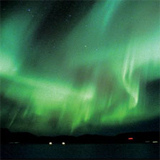|
Best time of day to see Northern Lights
The Northern lights offer a fantastic display shortly after sunset. They are hampered by light and therefore spectacular views will
be witnessed anytime from 10pm to 2am solar time. This time is widely regarded as most appropriate to guarantee the climax of the aurora activity. The solar time will vary based on a particular time of the year. Between April and October the solar time is referred to as the daylight savings time and basic calculations on time will be based on 2.5 hours after clock time while from November through March, the solar time is described as standard daylight time and comes after 1.5 hours.
These variations will automatically be translated to mean that the best time for seeing the aurora borealis during the period of winter is anytime between 11.30pm – 3.30am with the peak hour coming at 1.30am. However during the spring and fall seasons which fall between September and March, the Northern lights will give an awesome display from between 12.30am all the way to 4.30am with the peak display being witnessed at 2.30am. However impressive aurora displays may occur at any time when the sky is dark but these sights can be very unpredictable. Mostly observations witnessed around midnight are believed to yield better results.
The striking displays vary in intensity and will largely depend on whether the sky is clear and dark enough to give the much needed view of the aurora Borealis clear sky will always guarantee intense sights. However a partly cloudy sky may hamper a clear view. Also areas adorned with artificial lighting can distort the clear view regardless of the time. Most importantly, the aurora activity varies greatly from night to night and may not guarantee an automatic display and this is irrespective of whether or not the sky is clear.
Frequent displays can however appear during the months of March and September and this will largely be Dependant on clear skies and mild weather conditions. And during this time, the Aurora Borealis will either project a glowing curtain of greenish yellow lights or offer a multi-colored fusion that flashes the northern sky. The fantastic displays can however be hampered by phases of the moon. A full moon usually has far reaching implications on the spectacular displays and will in most cases detract from the display. Nevertheless, the emergence of new moon allows a fantastic display with the northern lights projecting at their best.
In areas surrounding the Northern region, the best time to get a fantastic view is around March and late September and October. This period has favorable weather which varies from mild weather to dark skies. Aurora displays in areas located far away from the aurora oval are not reliable since the magnetic field activity is unpredictable throughout the year. But despite the fact that the magnetic field that creates the light is active throughout the year, they hardly appear especially during summer due to the long daylight hours. The mid-winter temperatures on the other hand do not offer any pleasant view of the displays.
↑ Back to Top
|
|

|
|